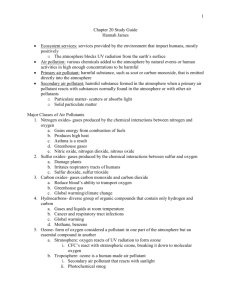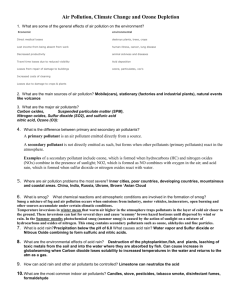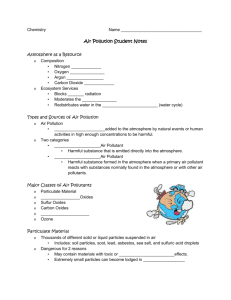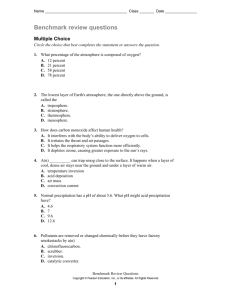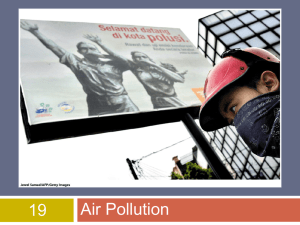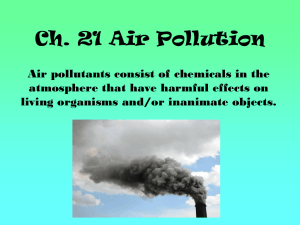Chapter 20: Air Pollution
advertisement
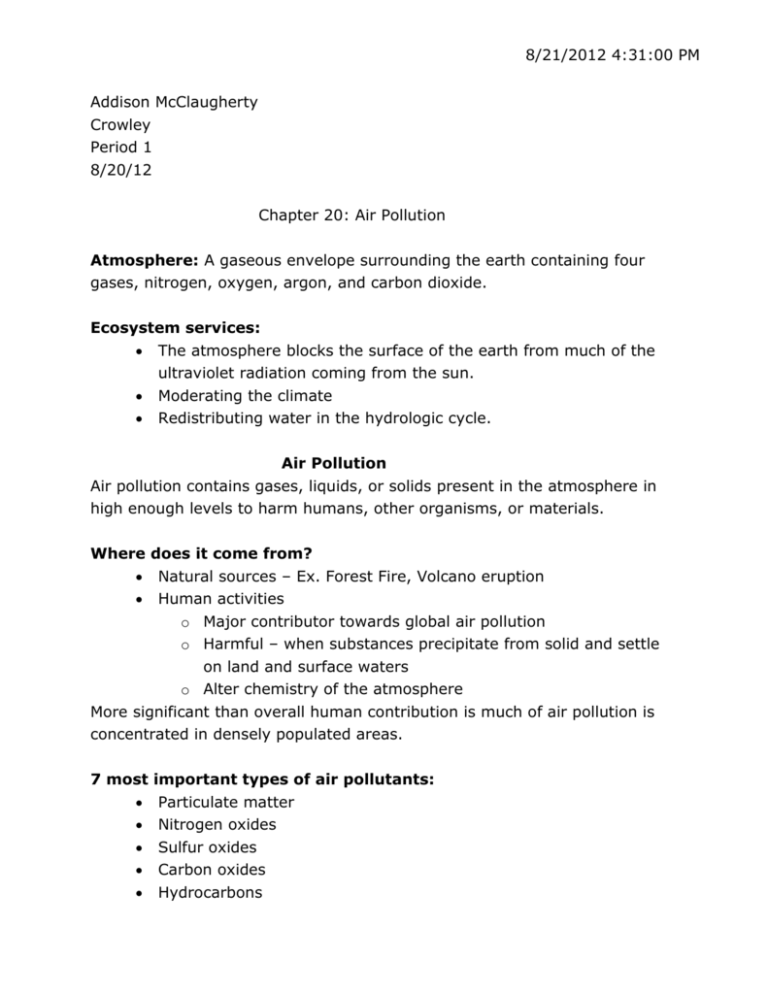
8/21/2012 4:31:00 PM Addison McClaugherty Crowley Period 1 8/20/12 Chapter 20: Air Pollution Atmosphere: A gaseous envelope surrounding the earth containing four gases, nitrogen, oxygen, argon, and carbon dioxide. Ecosystem services: The atmosphere blocks the surface of the earth from much of the ultraviolet radiation coming from the sun. Moderating the climate Redistributing water in the hydrologic cycle. Air Pollution Air pollution contains gases, liquids, or solids present in the atmosphere in high enough levels to harm humans, other organisms, or materials. Where does it come from? Natural sources – Ex. Forest Fire, Volcano eruption Human activities o Major contributor towards global air pollution o Harmful – when substances precipitate from solid and settle on land and surface waters o Alter chemistry of the atmosphere More significant than overall human contribution is much of air pollution is concentrated in densely populated areas. 7 most important types of air pollutants: Particulate matter Nitrogen oxides Sulfur oxides Carbon oxides Hydrocarbons Ozone Air toxics Primary Air Pollutants: are harmful chemicals that enter directly into the atmosphere. Major Ones o Carbon oxides o Nitrogen oxides o Sulfur dioxide o Particular matter o Hydrocarbons Secondary Air Pollutants: are harmful chemicals that form from other substances released into the atmosphere. Ozone and sulfur trioxide are secondary air pollutants because they are formed in a chemical reaction in the atmosphere. Particular Matter: consists of thousands of different solid and liquid particles suspended in the atmosphere. Solid Particulate matter o Dust Liquid matter o Mists Particulate matter: reduces visibility by scattering and absorbing sunlight. o Includes pollutants, Ex. Soil particles, soor, lead, asbestos, sea salt, sulfuric acid droplets. o Corrodes metals o Erodes buildings and sculptures when air is humid o Soils clothing and draperies Eventually particular matter settles out of atmosphere but some microscopic particles stay suspended for longer period of time Dangerous when inhaling o Contains traces of over 100 different chemicals Nitrogen Oxides: are gases produced by the chemical interactions between nitrogen and oxygen when a source of energy, such as combustion of fuels, produces high temperatures. Inhibits plant growth Causes asthma Involved in production of photochemical smog and acid deposition Corrodes metals Textiles to fade and deteriorate Global warming: nitrous oxides trap heat in the atmosphere and is there for a greenhouse gas which depletes the ozone in the stratosphere Sulfur Oxides: gas produced by chemical reactions between sulfur and oxygen. Colorless, nonflammable gas but has strong odor Causes acid deposition that corrodes metals and damage stone and other materials Sulfuric acids and sulfate salts produced in the atmosphere from sulfur oxides damage plants and irritates the respiratory system of humans and animals. Carbon Oxides: are the gases carbon monoxide and carbon dioxide. Carbon monoxide is produced in the largest quantities of any atmospheric pollutant except for carbon dioxide. Carbon dioxide is poisonous and reduces bloods ability to transport oxygen. o Greenhouse gas, its buildup in the atmosphere is linked with global warming Hydrocarbon: is a diverse group of organic compounds that contain only hydrogen and carbon Simplest hydrocarbon is methane o Principle component in natural gas Medium sized hydrocarbons such as benzene are liquid at room temperature although many are volatile and evaporate readily. Largest is paraffin Variety of effects on humans and other animals such as injury to the respiratory system and causes cancer. Methane is a potent greenhouse linked to global warming Ozone: is a form of oxygen considered a pollutant in one part of the atmosphere but an essential component in another. Oxygen reacts with UV radiation coming from the sun in the stratosphere to form the ozone. Pollutants have been reacting with the stratospheric ozone, breaking it down into molecular oxygen Ozone in the troposphere is a layer of atmosphere that is a human-made air pollutant. Secondary air pollutant Photochemical smog, reduces visibility and causes health problems. Stresses plants Chronic ozone exposure lowers crop yields, forest decline and contributes to global warming Hazardous air pollutants: Chlorine, lead, hydrochloric acid, formaldehyde, radioactive substances, and fluorides Potentially harmful Clean Air Act Amendments of 1990 meant to limit release of them Industrial smog: Smoke pollution composed of sulfur oxides and particulate matter photochemical smog: brownish-orange haze formed by chemical reactions involving sunlight nitrogen oxides, and hydrocarbons. temperature inversions: layer of cold air temporarily trapped near the ground by a warmer upper layer. Temperature inversions that persist in congested urban areas cause air pollutants to accumulate to dangerous levels. Health effects: irritation the eye, inflamed respiratory tract, and suppressed immune system. Constriction of airways which impairs the lungs ability to exchange gases Children have a bigger threat than adults because pollutants impedes lung development. They have weaker lungs and more likely to develop respiratory problems Electrostatic Precipitators and Scrubbers: An electrode imparts a negative charge to particulates in the dirty gas. These particles are attracted to the positively charged precipitator wall and then fall off into the collector. In a scrubber, mists of water droplets trap particulates in the dirty gas. The toxic dust produced by electrostatic precipitators and then polluted sludge produced by scrubbers bust be safely disposed of or they will cause soil or water pollution. Clean Air Act Authorizes the EPA to set limits on how much specified air pollutants are permitted in the states. Huge improvement in lead being released into the atmosphere along with other pollutants declining Global Distillation effect: process in which volatile chemicals evaporate from land as far away as the tropics and are transported by winds to higher latitudes, where they are condense and fall to the ground. Volatile chemicals contaminate some remote artic regions in result of the global distillation effect. Sick building syndrome: is the presence of air pollution inside office buildings that can cause eye irritations, nausea, headaches, respiratory infections, depression, and fatigue. Radon is a serious indoor air pollutant
